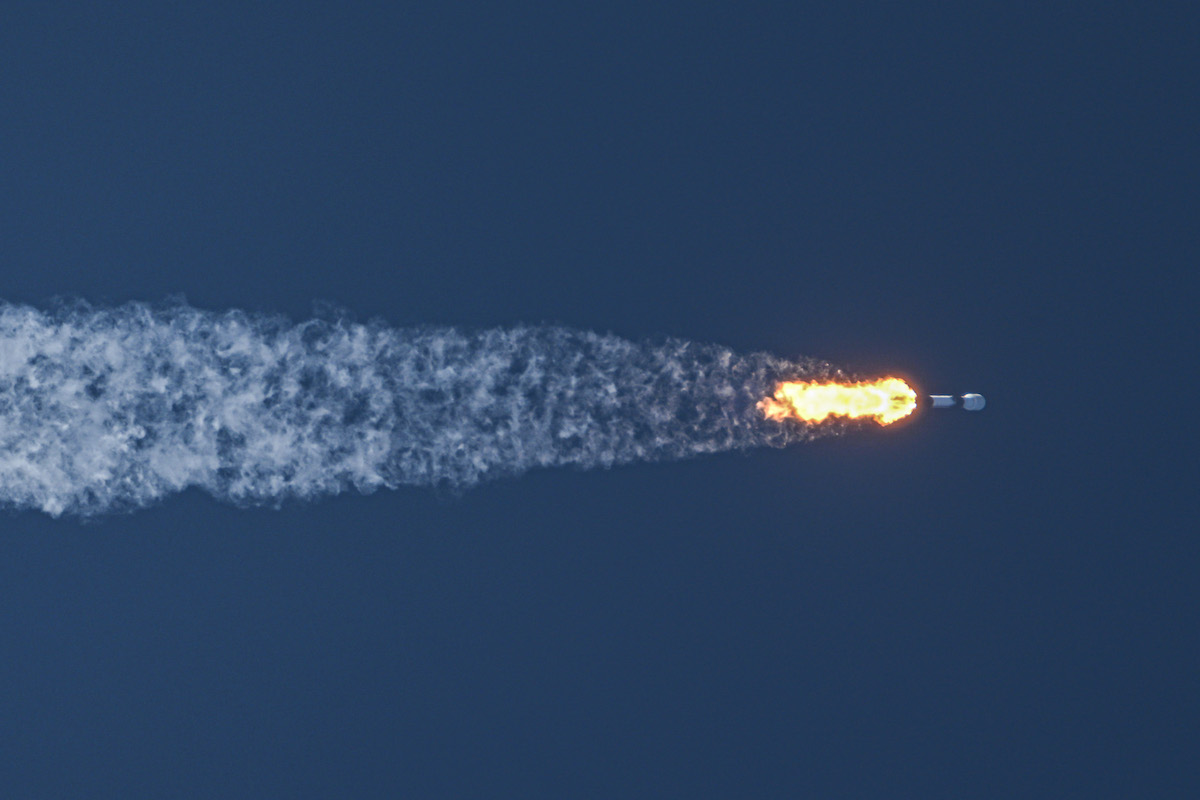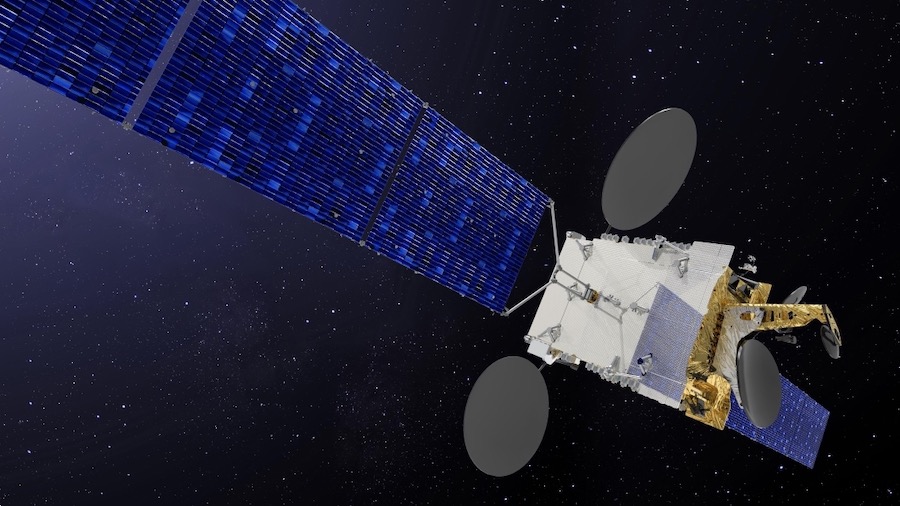
SpaceX launched an Egyptian communications satellite toward a high-altitude geostationary orbit Wednesday from Cape Canaveral. It was the first commercial launch of a geostationary payload this year, another sign of a market shift toward smaller, lower-orbiting communications satellites.
With the successful launch Wednesday, the Nilesat 301 satellite began a 15-year mission to provide Ultra HD television broadcast services and internet connectivity over Egypt and other parts of Africa and the Middle East.
The 229-foot-tall Falcon 9 rocket blasted off at 5:04 p.m. EDT (2104 GMT) Wednesday from pad 40 at Cape Canaveral Space Force Station in Florida, beginning a 33-minute mission to place the roughly 9,000-pound (4.1-metric ton) Nilesat 301 spacecraft into an elongated transfer orbit ranging nearly 28,000 miles (45,000 kilometers) above Earth.
The Falcon 9 delivered Nilesat 301 to an orbit inclined about 18.6 degrees to the equator, according to U.S. military tracking data.
Owned by the Egyptian operator Nilesat, largely controlled by Egypt’s government, the new satellite is destined for an operating position in a circular geostationary orbit, or GEO, more than 22,000 miles (nearly 36,000 kilometers) over the equator at 7 degrees west longitude, where it will provide TV broadcast and internet services.
The spacecraft will use its own propulsion system for the final maneuvers to reach its operational orbit.
The launch Wednesday was the 23rd Falcon 9 launch of the year, and the first with a satellite heading toward geostationary orbit, a popular location for TV broadcasting and data relay spacecraft. It was also the first truly commercial launch into a geostationary transfer orbit worldwide this year.
The geostationary satellite launch market was once a lucrative business for launch providers, including SpaceX. But the satellite market has shifted to smaller spacecraft, including constellations flying in low Earth orbit, or LEO, to beam broadband signals to consumers.
Geostationary satellites are typically large and carry more communications capacity than a single LEO telecom spacecraft. In geostationary orbit, they orbit in lock-step with Earth’s rotation, allowing an antenna on the ground to point at the same place in the sky for a continuous link with the satellite.
SpaceX operates the Starlink network, the world’s largest fleet of satellites, and other companies are in the process of developing and deploying their own low-orbit constellations.

“Having a first commercial GEO launch this late in the year is illustrative of a softer GEO market and growing demand for LEO missions,” said Caleb Henry, a senior industry analyst at Quilty Analytics.
But there is more to the story, Henry said.
In 2018, commercial satellite operators ordered just five traditional large geostationary communications spacecraft from manufacturers. With most large satellites requiring a few years to build and prepare for launch, the low number of geostationary satellite orders in 2018 is now resulting in a slow year for geostationary launches, according to Henry.
There were 11 commercial geostationary satellite orders in 2019, but that number was still well below the industry average of 20 in previous years, Henry said.
There are two other factors impacting the geostationary satellite business, Henry said.
The COVID-19 pandemic slowed satellite construction and exposed problems in global supply chains. And many of the geostationary satellites that were ordered in recent years are geared toward very high throughput missions. Those often require the design and development of new technology and first-of-their-kind reconfigurable payloads, resulting in longer build times, Henry said.
Some of the new very high throughput satellites designed for geostationary orbit are still in development.
Nilesat 301 separation confirmed.
The 4.1-metric ton French-built, Egyptian-owned communications satellite is flying free of its Falcon 9 launcher to begin a 15-year mission. Next up are solar array deployment and orbit-raising maneuvers.https://t.co/HJ1nkE70ng pic.twitter.com/1BFPfK3Sck
— Spaceflight Now (@SpaceflightNow) June 8, 2022
Built in France by Thales Alenia Space, Nilesat 301 will replace the Nilesat 201 spacecraft launched in 2010.
“The capabilities of the new satellite also include providing broadband internet services to cover the Arab Republic of Egypt and remote areas to provide internet services for new projects, infrastructure projects, new urban communities, and oil fields in the eastern Mediterranean, especially the Zohr field,” Nilesat said on its website.
Thales delivered Nilesat 301 to Cape Canaveral last month after a trans-Atlantic trip by boat from France. The launch of Nilesat 301 was delayed from late April after the planned means of transport — a Russian-owned Antonov cargo plane — became unavailable in the wake of sanctions imposed by Western governments due to Russia’s invasion of Ukraine.
Nilesat 301 hosts Ku-band and Ka-band telecom payloads, including 38 transponders, to broadcast signals to Nilesat customers. Nilesat 301 will replace and expand coverage provided by Nilesat 201, reaching new customers in East Africa and sub-Saharan Africa.
“We look into the future with many strategic partnerships among our fellow African countries, and for this Nilesat has built its vision towards its natural expansion in the sub-Saharan Africa with the new Nilesat 301 satellite,” Nilesat said.
Established in 1996, Nilesat says its current satellites reach more than 56 million households with more than 270 million viewers across North Africa, the Middle East, and the Gulf regions.
The new Nilesat 301 satellite is the fourth to be procured and launched for Nilesat, which also leases capacity on third-party communications satellites.
Nilesat 301 will also operate in tandem with the TIBA 1 satellite directly owned by the Egyptian government. TIBA 1, which launched in 2019, provides civilian and military broadband and data relay services.
‘We are delighted to continue supporting Nilesat in this growth by delivering customized satellite products with outstanding performance”, said Hervé Derrey, CEO of Thales Alenia Space. “This achievement proves that our telecommunications offer perfectly replies to the telecom market’s needs and that we are perfectly capable of providing tailored solutions that meet each operator’s specific requirements, to enhance global connectivity and reduce the digital divide.”

While the Falcon 9 rocket’s upper stage delivered Nilesat 301 into orbit Wednesday, the Falcon 9’s first stage returned to Earth for recovery after completing its two-and-a-half minute burn to boost the satellite off the ground.
After staging, the booster coasted through space for a few minutes before plunging back into the atmosphere to target a vertical, rocket-assisted landing on SpaceX’s drone ship in the Atlantic nearly nine minutes after liftoff.
The Falcon 9’s first stage — tail number B1062 — completed its seventh flight with a bullseye landing on SpaceX’s floating drone ship about 420 miles (680 kilometers) east of Cape Canaveral. The booster debuted with the launch of a U.S. military GPS satellite on Nov. 5, 2020, and has since launched another GPS payload, the Inspiration4 and Axiom’s Ax-1 private astronaut missions, and two missions carrying Starlink internet satellites into orbit.
On seven flights, the booster has now carried 105 satellites and eight people toward orbit.
Nilesat 301’s launch was the first of up to six Falcon 9 rocket flights scheduled for June. Next on SpaceX’s schedule are the launch of a German military radar observation satellite from California on June 18, and two missions in mid-to-late June from Florida with a Globalstar data relay satellite and more Starlink internet relay spacecraft.
Email the author.
Follow Stephen Clark on Twitter: @StephenClark1.
